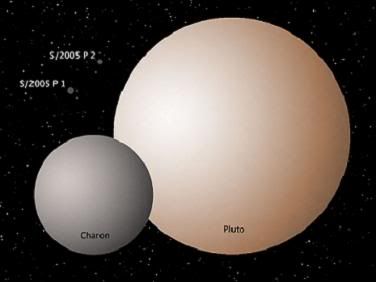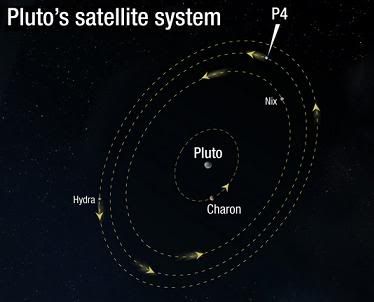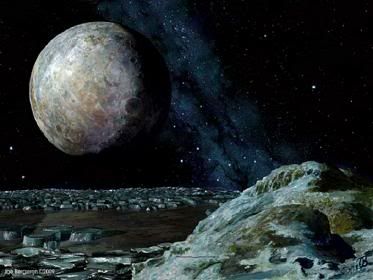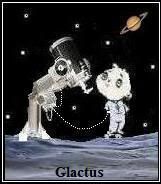Post by glactus on Oct 7, 2011 0:51:38 GMT
Pluto has four known moons. The largest, Charon, is proportionally larger, compared to its primary, than any other satellite of a known planet or dwarf planet in the Solar System. The other moons, Nix, Hydra, and S/2011 P 1 are much smaller.

Pluto and its moons
The innermost moon, Charon, was discovered by James Christy on June 22, 1978, nearly half a century after Pluto. Two outer moons were imaged by the Hubble Space Telescope Pluto Companion Search Team in May 2005, and precovered from Hubble images taken in June 2002. With the orbits confirmed, the moons have been given definitive names.. Further Hubble observations were made in February and March 2006. The possibility of rings created by impacts on the smaller moons will be investigated by the New Horizons probe. The fourth moon was announced in July 2011.

Pluto's satellite system
Pluto and Charon have been called a double planet because Charon is larger compared to Pluto (half its diameter and an eighth its mass) than any other moon is to a planet; indeed Charon is massive enough that, despite their proximity, Pluto orbits the system's barycenter at a point outside its surface. Charon and Pluto are also tidally locked, so that they always present the same face toward each other.

The Dwarf planet Pluto from Charon
When discovered, Hydra was somewhat brighter than Nix, and therefore thought to be larger by 20%, but follow-up observations found them to be nearly identical. It is likely that the change in brightness is due to the light curve of Hydra, but whether this is due to an irregular shape or to a variation in surface brightness is unknown.
To see video of Pluto just click on the link below. Has sound
science.discovery.com/videos/space-school-pluto.html

Credits: These are non copywrite images
Text by Wikipedia
Video by Space school

Pluto and its moons
The innermost moon, Charon, was discovered by James Christy on June 22, 1978, nearly half a century after Pluto. Two outer moons were imaged by the Hubble Space Telescope Pluto Companion Search Team in May 2005, and precovered from Hubble images taken in June 2002. With the orbits confirmed, the moons have been given definitive names.. Further Hubble observations were made in February and March 2006. The possibility of rings created by impacts on the smaller moons will be investigated by the New Horizons probe. The fourth moon was announced in July 2011.

Pluto's satellite system
Pluto and Charon have been called a double planet because Charon is larger compared to Pluto (half its diameter and an eighth its mass) than any other moon is to a planet; indeed Charon is massive enough that, despite their proximity, Pluto orbits the system's barycenter at a point outside its surface. Charon and Pluto are also tidally locked, so that they always present the same face toward each other.

The Dwarf planet Pluto from Charon
When discovered, Hydra was somewhat brighter than Nix, and therefore thought to be larger by 20%, but follow-up observations found them to be nearly identical. It is likely that the change in brightness is due to the light curve of Hydra, but whether this is due to an irregular shape or to a variation in surface brightness is unknown.
To see video of Pluto just click on the link below. Has sound
science.discovery.com/videos/space-school-pluto.html
Credits: These are non copywrite images
Text by Wikipedia
Video by Space school


